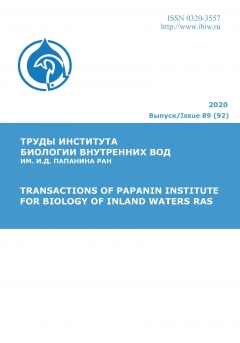UDC 546.654
The responses of the laboratory culture Hyalella azteca to the effect of lanthanum sulfate solutions in the concentration range of 0.16–160 μmol/l under conditions of a chronic trial were studied. It was shown that the mortality of H. azteca increased with an enhance in the concentration of La3+ in the solution. A consistent increase in the concentration of La3+ led to a natural raise in food consumption. The most informative test function in assessing the toxicity of La3+ is the length and weight of H. azteca, while the length and number of antennal segments are not informative.
lanthanum, bioassay, survival, growth, feeding behavior, Hyalella azteca, chronic toxicity
1. Kabata-Pendias A., Kabata-Pendias H. Mikroelementy v pochvah i rasteniyah. M.: Mir, 1989. 439 s.
2. Lozhkina R.A., Tomilina I.I. Vliyanie lantana na biologicheskie parametry vetvistousogo rachka Ceriodaphnia affinis v hronicheskom eksperimente // Toksikologicheskiy vestnik. 2016. № 1(136). S. 42–46. DOI:https://doi.org/10.36946/0869-7922-2016-1-42-42.
3. Odum Yu. Ekologiya: V 2-h t. Ecology / Per. s angl. M.: Mir, 1986. T. 1. 328 s.; T. 2. 376 s.
4. Ol'kova A.S., Mahanova E.V. Vybor biotestov dlya ekologicheskih issledovaniy vod, zagryaznennyh mineral'nymi formami azota // Voda i ekologiya: problemy i resheniya. 2018. № 4(76). S. 70–81. DOI:https://doi.org/10.23968/2305-3488.2018.23.4.70-81.
5. Rybal'skiy N.G. Ekologicheskie aspekty ekspertizy izobreteniy: spravochnik eksperta i izobretatelya. M.: VNIIPI, 1989. Ch. 1. S. 139.
6. Rybina G.E., Mihaylova L.V., Tomilina I.I. Metodika opredeleniya toksichnosti donnyh otlozheniy, pochv, osadkov stochnyh vodi promyshlennyh othodov metodom biotestirovaniya s ispol'zovaniem amfipod Hyalella azteca Saussure. S-Pb: OOO “Spektr-M”, 2019. 42 s.
7. SanPiN 2.1.4.1074-01. Pit'evaya voda. Gigienicheskie trebovaniya k kachestvu vody centralizovannyh sistem pit'evogo vodosnabzheniya. Kontrol' kachestva. 2010. http://www.stroyoffis.ru/sanpin_sanitar/sanpin_2_1_4_1074_01/sanpin_2_1_4_1074_01.php
8. Sysolyatina M.A., Ol'kova A.S. Potencirovanie toksicheskogo deystviya medi v prisutstvii lantana v biotestah na Daphnia magna Straus (Cladocera, Crustacea) // Povolzhskiy ekologicheskiy zhurnal. 2022. № 4. S. 483–490. DOI:https://doi.org/10.35885/1684-7318-2022-4-483-490.
9. Filenko O. F., Terehova V. A. Ekologicheskoe prednaznachenie biotestirovaniya: informativnost' i universal'nost' // Biodiagnostika i ocenka kachestva prirodnoy sredy: podhody, metody, kriterii i etalony sravneniya v ekotoksikologii: Materialy mezhdunarodnogo simpoziuma i shkoly, Moskva, 25–28 oktyabrya 2016 goda. Moskva: Izdatel'stvo GEOS, 2016. S. 232–238.
10. Blinova A., Lukjanova M., Muna H., Vija H., Kahru A. Evaluation of the potential hazard of lanthanides to freshwater microcrustacean // Sci. Total. Environ. 2018. Vol. 642. P. 1100–1107. DOI:https://doi.org/10.1016/j.scitotenv.2018.06.155.
11. Borgmann U., Couillard Y., Doyle P., Dixon D.G. Toxicity of sixty-three metals and metalloids to Hyalella azteca at two levels of water hardness // Environ. Toxicol. Chem. 2005. Vol. 24. P. 641–652. DOI:https://doi.org/10.1897/04-177r.1.
12. Figueiredo C., Grilo T.F., Lopes R. et al. Single and combined ecotoxicological effects of ocean warming, acidification and lanthanum exposure on the surf clam (Spisula solida) // Chemosphere. 2022. Vol. 302. Article 134850. DOI:https://doi.org/10.1016/chemosphere.2022.134850.
13. Gad S.C. Animal Models in Toxicology (3rd ed.). CRC Press. 2016. 1168 p. DOI:https://doi.org/10.1201/b18705.
14. Gupta C.K., Krishnamurthy N. Extractive metallurgy of rare earths // International materials reviews. 1992. Vol. 37. № 1. P. 197–248.
15. Hargrave B.T. The Utilization of Benthic Microflora by Hyalella azteca (Amphipoda) // Journal of Animal Ecology. 1970. Vol. 39(2). P. 427–437. DOI:https://doi.org/10.2307/2980.
16. Henderson P. Rare earth element geochemistry. Elsevier, 2013. 510 p.
17. Herrmann H., Nolde J., Berger S., Heise S. Aquatic ecotoxicity of lanthanum- a review and an attempt to derive water and sediment quality criteria // Ecotox. Environ. Saf. 2016. Vol. 124. P. 213–238.
18. Ingersoll C.G., Besser J.M., Brumbaugh W.G. et al. Sediment chemistry, toxicity, and bioaccumulation data report for the US Environmental Protection Agency–Department of the Interior sampling of metal-contaminated sediment in the Tri-state Mining District in Missouri, Oklahoma, and Kansas. U.S. Geological Survey and MacDonald Environmental Sciences. 2008.
19. Ingersoll C.G., Nelson M.K. Testing sediment toxicity with Hyalella azteca (Amphipoda) and Chironomus riparius (Diptera) // Aquat. Toxicol. and Risk Assessment. Philadelphia: Amer. Soc. Test. and Mater, 1990. Vol. 13. P. 93–109.
20. Johnson I., Persoone G., Janssen C., Coen W.M.De. Criteria-based procedure for selecting test methods for effluent testing and its application to Toxkit // New York: Kluwer Academic/Plenum Publishers, 2000. P. 73–94.
21. Liu W.S., Guo M.N., Liu C. et al. Water, sediment and agricultural soil contamination from an ion adsorption rare earth mining area // Chemosphere. 2019. Vol. 216. P. 75–83. DOI:https://doi.org/10.1016/j.chemosphere.2018.10.109.
22. Lu C. The Effects of Water Chemistry and Organism Source on Dysprosium Toxicity to Hyalella azteca (Master's thesis, University of Waterloo). Waterloo, Ontario: University of Waterloo, 2016. 126 p.
23. Nelson M.K., Brunson E.L. Postembryonic growth and development of Hyalella azteca in laboratory cultures and contaminated sediments // Chemosphere, 1995. Vol. 31. № 4. P. 3129–3140.
24. Norwood W.P., Borgmann U., Dixon D.G. Chronic toxicity of arsenic, cobalt, chromium and manganese to Hyalella azteca in relation to exposure and bioaccumulation // Environmental Pollution. 2007. Vol. 147(1). P. 262–272.
25. Odum W.E., Drifmeyer J.E. Sorption of pollutants by plant detritus: a review // Environmental Health Perspectives. 1978. Vol. 27. P. 133–137.
26. Olkova A.S., Kantor G.Y., Kutyavina T.I., Ashikhmina T.Y. The importance of maintenance conditions of Daphnia magna Straus as a test organism for ecotoxicological analysis // Environmental Toxicology and Chemistry. 2018. Vol. 37. № 2. P. 376–384. DOI:https://doi.org/10.1002/etc.3956.
27. Sadchikov A.P., Ostroumov S.A. Issues of the study of detritus in aquatic systems // Russian Journal of General Chemistry. 2017. Vol. 87. P. 3244–3249. DOI:https://doi.org/10.1134/S1070363217130199.
28. Sokal R.R., Rohlf F.J. Biometry: the principles and practice of statistics in biological research. N.Y.: W.H. Freeman and Comp., 1995. 887 p.
29. Wang Z., Shu J.H., Wang Z.R. et al. Geochemical behavior and fractionation characteristics of rare earth elements (REEs) in riverine water profiles and sentinel clam (Corbicula fluminea) across watershed scales: insights for REEs monitoring // Sci. Tot. Environ. 2022. Vol. 803. Article 150090. DOI:https://doi.org/10.1016/j.scitotenv.2021.150090.
30. Wang Z., Yu S., Zhang L. et al. Effects of simazine herbicide on a plant-arthropod-lizard tritrophic community in territorial indoor microcosms: Beyond the toxicity // Science of The Total Environment. 2021. Vol. 781. P. 146723. DOI: 10/1016/j.scitotenv.2021.146723.
31. Zhi Y., Zhang C., Hjorth R. et al. Emerging lanthanum (III)-containing materials for phosphate removal from water: A review towards future developments // Environment International. 2020. Vol. 145. P. 106115. DOI:https://doi.org/10.1016/j.envint.2020.106115.








